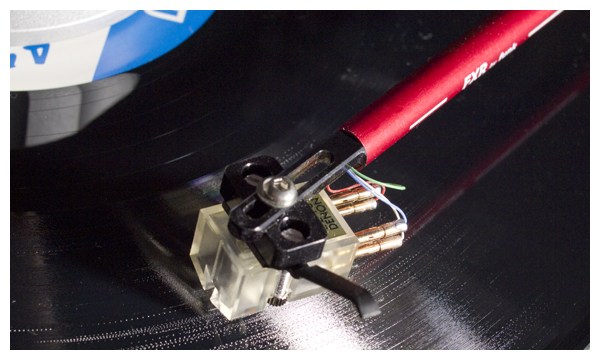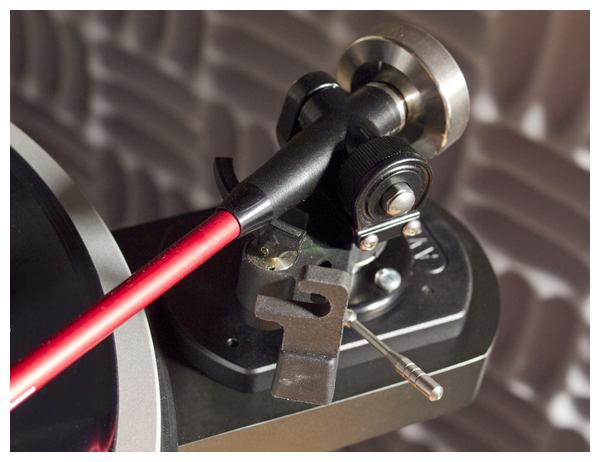Funk Firm Has A Winner…
Refinement constitutes the difference between P1 and P6 on the Formula One grid. The same can be said for analog reproduction. While there’s precious little genuinely new under the sun, careful refinement of existing technology continues to extract more information from the grooves of our vinyl collections. And it’s a huge bonus when performance increases do not cost a king’s ransom. Such is the case with the Funk Firm FX•R tonearm.
At $1,995 (with cable attached), the FX•R is competitively priced with its peers, the SME 309 ($2,295) and Rega RB1000 ($1,995). As detailed below, extended listening proves the FX•R as quite the bargain. Reviewed here is the $2,200 model with 5 – pin DIN plug to allow the tonearm cable of your choice.
Some might brush off the FX•R off as another modded Rega arm. But this model goes beyond the traditional rewire and damping treatment supplied by most purveyors. Three versions are available: the standard FX•R, with a mount similar to the original RB300; the FX•RII, with a winged mount like the RB 600-1000 arms possess; and a third model that acts as a “drop in” replacement for the Linn LP-12 arms.
The FX•R provides VTA adjustment and a 5-pin tonearm cable plug. The “simple cartridge mount” is the only feature that throws me for a loop, as it’s still as much work as any other ‘table lacking removable headshells. However, the clips that connect to the cartridge pins are much more robust than the standard Rega items—an excellent upgrade. For a complete technical explanation of the FX•R’s construction click here.
Courtesy of its small diameter and cross-bracing scheme, the arm tube represents the FX•R’s biggest variation on theme. By eliminating several common resonance and vibration issues, the FX•R claims to provide more solid bass response, a more open midrange, and greater low-level detail retrieval than other arms. ABEC–7 grade bearings (the same level of quality used in the SME V tonearm) are substituted for standard Rega bearings. A complete rewiring is also executed.
While I’m not in the habit of performing product shootouts, doing so seemed too intriguing to skip, and with an RB1000 and SME 309 on hand, along with a pair of AVID Volvere SP turntables, I threw down the gauntlet. A pair of Sumiko Pearwood cartridges were used for the comparison, and both ‘tables were optimized with the Feickert Adjust + system. Plugging both ‘tables into the magnificent Vitus Audio MP-P201 phonostage allowed effortless A/B comparisons in real time. Moreover, thanks to its pivoted headshell, the FX•R is quickly brought into alignment, with bias and tracking force set as you would any other Rega arm. The adjustable VTA is most welcome.
 Wow Factor
Wow Factor
Via the FX•R, Thomas Dolby’s “I Scare Myself” from The Flat Earth and the Art of Noise’s “Camilla: The Old, Old Story” from In Visible Silence each reveal a significantly larger soundstage than to which I’m accustomed. Since they’re heavily processed, the songs certainly don’t tell much about tonal accuracy. Yet their overblown soundstage and attention-to-minute detail handily disclose a component’s ability to reproduce spatial cues.
Acoustic and vocal tracks, especially those with layered harmonies, disclose the efforts made to control resonance on the FX•R. An ideal example comes from Amy Winehouse and Tony Bennett’s “Body and Soul,” a duet on the former’s posthumous Lioness: Hidden Treasures. The singers personify smooth, and the result feels like one is listening to open-reel tape. Both voices hang in the air, filling the room, each taking a very distinct space in front of the listening chair.
Arguably, a violin is the toughest thing for analog to convincingly reproduce. Again, the FX•R impresses. Listening to a young Anne Sophie Mutter play Mozart violin concertos on a 1982 DG release equates to bliss, the music emanating without a hint of screechiness even though DG recordings can tilt toward the bright side.
Most convincingly, the FX•R delivers prodigious bass information—the entire trifecta of weight, detail, and control. This is what separates good tonearms from great ones. On classic Boogie Down Productions hip-hop, omnipresent grunt balances the driving reggae beat in “Bo! Bo! Bo!” (from the group’s Ghetto Music: The Blueprint of Hip Hop) while keeping the percussion tidy. At the opposite end of the aural spectrum, Jaco Pastorius’ self-titled album dishes up an abundance of bass texture and speed, through which the FX•R sails.
Head to Head
Initial excitement gleaned from new components makes it easy to get caught up in the moment and issue grandiose proclamations. Two identical ‘tables, with the only variable being the tonearm and a cache of duplicate titles from Mobile Fidelity, allow for context and streamline the comparison process.
Having spent hundreds if not thousands of hours with the SME 309 and Rega RB1000, these arms with which I’m not only very familiar but very fond. The SME’s removable headshell and easy adjustability are big pluses for anyone with multiple cartridges. Yet the rigidity lost at the headshell-to-arm junction costs a bit of upper bass weight. The RB1000 renders great top-to-bottom response and is incredibly easy to set up and use, especially with a Rega cartridge. However, the lack of adjustability is the price one pays in a non-Rega setup.
 Funk Firm’s “Think of [the FX•R] as a Ford Cosworth or an AMG Mercedes” pitch repeatedly comes to mind during listening sessions. With direct comparisons via MoFi’s recent remasters of James Taylor’s JT and Rod Stewart’s Gasoline Alley, the FX•R always digs deeper into the music, not only painting a bigger sound space but rewarding with more decay and bits of information obscured by the other setup. Isn’t this what it’s all about for maniacal audiophiles?
Funk Firm’s “Think of [the FX•R] as a Ford Cosworth or an AMG Mercedes” pitch repeatedly comes to mind during listening sessions. With direct comparisons via MoFi’s recent remasters of James Taylor’s JT and Rod Stewart’s Gasoline Alley, the FX•R always digs deeper into the music, not only painting a bigger sound space but rewarding with more decay and bits of information obscured by the other setup. Isn’t this what it’s all about for maniacal audiophiles?
There’s no question the FX•R extracts more music from grooves than the SME 309 or Rega RB1000. Warhorse tracks I’ve heard many times before always bring forth previously unnoticed details. Slayer had more bite, Sonic Youth more grit, and even Led Zeppelin’s “Stairway to Heaven” is again a pleasure.
Makes the Grade
This is all about subtlety, for which one usually needs to shell out big bucks in analog. It’s refreshing to see a component this good that isn’t out of reach of most audiophiles. Even with a modest cartridge, the Funk Firm FX•R sets a new benchmark for what’s possible at $2,000 and still, remains up to task by going beyond the Sumiko Pearwood and moving up to the Sumiko Palo Santos, Koetsu Urushi Blue, and SoundSmith Susurro Paua by taking advantage of these premium cartridges’ additional resolution.
I’m happy to award the FX•R an Exceptional Value Award for 2012. This fine tonearm is now an integral part of my analog arsenal, and I look forward to investigating more of the company’s offerings. Very highly recommended.
The Funk Firm FX•R Tonearm
MSRP: $1,995 (with captive cable)
$2,200 (five pin -DIN)
$2,500 (12″ cable)
$2,600 (12″ sans cable)
Manufacturer’s Information
http://www.thefunkfirm.co.uk


